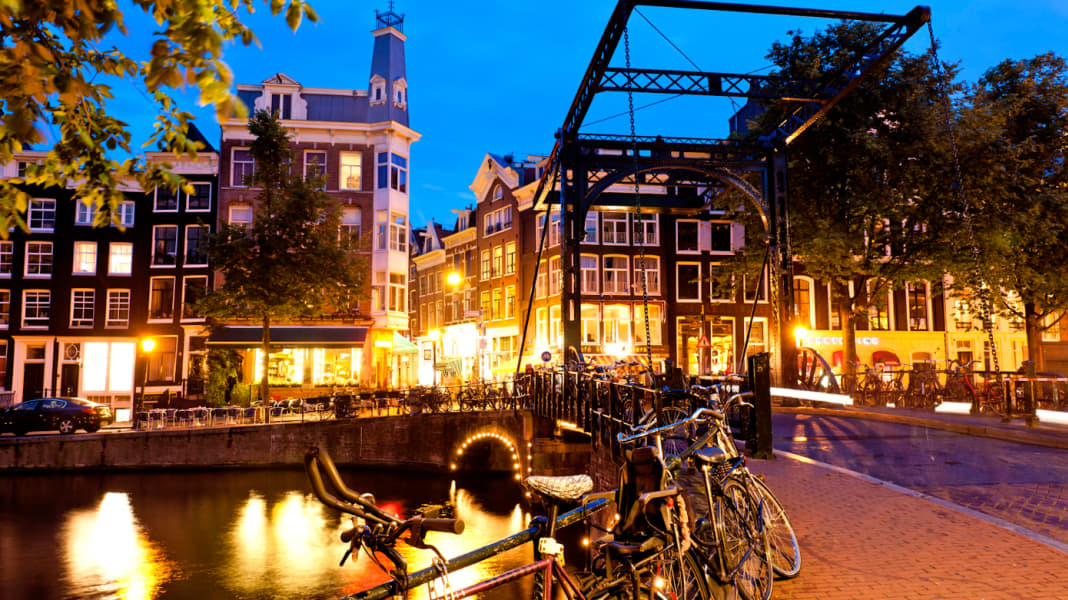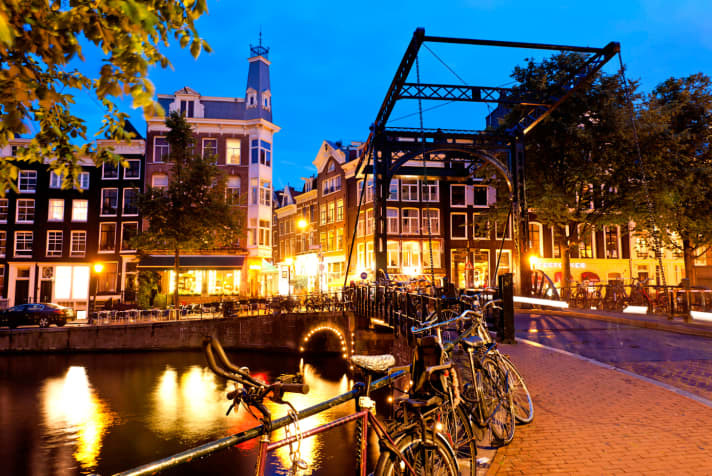







It was at the regulars' table. Someone told us how he had stored his steel displacer in the Sixhaven and then travelled across the IJ in his dinghy to tackle Amsterdam's canal belt on his own keel. We were told that he only found his way out again thanks to the GPS, and we were very impressed by the obvious drama of the trip. Amsterdam by boat - as if the city that our worried parents once kept us away from wasn't exciting enough! But then we wanted to find out.

The first thing we did was to get a boat from Jan Pieter Groeneveld. Jan Pieter is the boss of Boaty Bootverhuur. A standing desk and a jetty with boats are all he needs to run his business on Jozef Israelskade in the De Pijp neighbourhood. The neighbourhood used to be a working-class district, but today the corner is hip. Exotic eateries, fun shops, multiculturalism. How it is. Boaty rents out aluminium boats with electric drives. The juice that flows from the sockets at the jetty is eco-friendly.

And the power of the motors? Jan Pieter waves it off: "kW - hardly worth mentioning." However, the 5 metre long "Friese schouw" sloops make surprisingly fast progress. The battery lasts all day, Jan Pieter promises. And then he gives us the advice to stay defensive and keep an eye on the tour boats. Does much actually happen on the canals? "I think it usually goes well," says Jan Pieter succinctly and pushes us off the jetty.
If you were to string Amsterdam's canals together, they would cover a distance of around 75 kilometres. In comparison, the 45 kilometres of the Rhine-Herne Canal are somewhat modest. Venice should also keep a low profile - Amsterdam allegedly has three times as many bridges as the Serenissima. Amsterdam's 165 canals form a semi-circular network that runs through and surrounds the city centre. Amsterdam's canal belt has been a UNESCO World Heritage Site since 2010. The Amstel is much less talked about, although it and a dam built in the Middle Ages gave the city its name - Amsterdam.
A 9-metre cruiser passes us on the Amstel, then a tour boat. Our aluminium sloop is unimpressed, as are we - the Amstel is wide. The venerable Amstel Hotel has hoisted the city flag: red-black-red with three white St Andrew's crosses. Nobody really knows why the cloth looks the way it does. The (open) Amstel locks are followed by Amsterdam's famous "Magere Brug". It is just as pretty as in the guidebook. The "skinny" is just a reminder that the first version of the bridge in the 17th century was a rather narrow shirt.
The "Hermitage" on our starboard side is the daughter of another Hermitage - the one in St. Petersburg. Perhaps it would never have been built if a tsar had not hired himself out as a carpenter in the area and kept his eyes and ears open. Peter the Great liked what he saw around Amsterdam in 1697/98. He copied a lot and took the Dutch to his heart, which in turn pleased them. The Russo-Dutch affinity has survived the centuries and is also being celebrated this year (see info box). We set our sights on other highlights. Ahead of us lies De Wallen, Amsterdam's famous red light district.
As a water tourist without any ulterior motives, you usually take the canal along the Oudezijds Voorburgwal to get into the district and the canal along the Oudezijds Achterburgwal back - or vice versa. The canal along the Oudezijds Achterburgwal is closed to traffic today, so the Oudezijds Voorburgwal will have to suffice for us to peer into the neighbourhood without commitment. Many others do the same. Appropriate tours are offered, for example by the local tourist office. Those who find such an arrangement too theoretical can simply book a seminar on window prostitution at the Prostitutie Informatie Centrum (PIC). De Wallen is considered relatively safe and we don't really find it a cause for concern here.
We pass coffee shops and other establishments that are self-explanatory. A place of worship comes into view, the Oude Kerk, Amsterdam's oldest building. Its history dates back to the 13th century. Sloepen, packed with travellers, accompany us. The mood is relaxed. - Then we catch the gaze of a woman offering herself behind a shop window and her eyes tell us about a reality that we had almost suppressed. We put in our oars and head back.
If you need a "kopje koffie" now, you can moor at "Café de Jaren" at the entrance to the canal on the Kloveniersburgwal. Mooring in the city in general. It's not quite that simple (see info box). We have also internalised the advice of Jan Pieter's colleague Wout: "Don't leave the boat unattended!" Amsterdam is not a boarding school for girls, no matter how safe we may feel.
Middle of the 16th century. Amsterdam is barely larger than De Wallen with a few more streets. The city is still only bordered by a system of moats between the Singel and Gelderskade. But times are changing. The Netherlands is on the eve of its greatest era, the Golden Age. More and more people are moving to Amsterdam, and soon the city is crowded.
The town expands twice, but it is not a great success. A third expansion followed at the beginning of the 17th century, and later a fourth. This time the concept was grandiose: the world-famous canal belt was built. First of all, the Heren-, Keizers- and Prinsengracht canals were created as the main canals to the west of the Singel. A new moat, the Singelgracht, follows. In 1613, exactly 400 years ago, construction work began on the canal belt, an anniversary that the people of Amsterdam naturally don't want to miss out on.
We don't miss the GPS, because the canal belt has a system. We are now travelling along the Singel, passing the floating flower market and the Torensluis Bridge dating from 1648, which takes a while to cross. The structure is around 40 metres wide, a real block that once had a practical dual function - as a bridge and a prison. Then, almost at the Brouwersgracht, we see a houseboat full of chicks, but this time they are real ones. For almost 50 years, the "cat boat" has been providing a roof over the paws of beleaguered mousers.
A little further on, hidden between the façades, we discover a building dwarf - the house with the narrowest view in the whole of Amsterdam. The front facing the canal is only around one metre wide. A clever fox saved a lot of tax back then. We turn into Brouwersgracht, which is part of the Jordaan, a neighbourhood that is perhaps even more iconic than De Pijp. The Jordaan was also a poor neighbourhood. When the hardship became unbearable in the early 1930s, the residents took action against the authorities with cobblestones. The authorities reacted immediately - by removing the cobblestones and replacing them with asphalt.
There - a loud bang. A sloop has hit a canal wall with a roar. The amateur skipper has underestimated the swinging stern of a tour boat and now looks rather dismayed. A barge full of young badgers soon takes aim at us as they swiftly and cheerfully round a corner. "Pas op!" - We just about manage to pass each other. We wouldn't have liked to have had the landing craft, which is doing a roaring lap, as a sparring partner.
Mirrors usually help at tricky junctions, otherwise keeping a lookout is the be-all and end-all. Hardly anyone uses horns. We don't need to blow our horns either, which Jan Pieter would like. Driving a whisper boat and then making a racket, no, for him that doesn't go together. The Heren-, Keizers- and Prinsengracht canals branch off from the Brouwersgracht. They are the pearls of the canal belt. The Herengracht is home to the most magnificent canal houses in Amsterdam.
Here, in the "Gouden Bocht", is where the 17th and 18th century aristocracy lived. On the Keizersgracht, near the Westerkerk, we notice an installation: a triangle of pink granite that juts out into the canal like a pedestal. The triangle is one of three that form part of the Homomonument. Its symbolism is also a reminder of the infamous pink triangle used by the National Socialists to stigmatise deported homosexual men.12 June 1942.
A young girl in Amsterdam turns 13. Among her presents is a notebook, chequered in white and red and with a little fastener - a diary. She calls it "Kitty" and begins to write. The girl, Anne Frank, grows up in a country occupied by the Nazis. For the Jews, the situation becomes more dangerous by the day, including for the Jewish Frank family. On 6 July 1942, she goes into hiding.
The hiding place in the rear building of Prinsengracht 263 remains undiscovered for two years, then its inhabitants are betrayed and deported. Anne Frank dies at the age of 15 in the Bergen-Belsen concentration camp. Her father survives and publishes her diary. It still touches people around the world today. As we pass Prinsengracht 263, a long queue of people has once again formed in front of the entrance to the Anne Frank House. Many of those queuing are barely older than Anne was back then. "I want to live on after my death," she wrote in her diary on 4 April 1944 (quoted from the Fischer Taschenbuch Verlag edition, 45th edition).
Anne's wish has been fulfilled. From the Prinsengracht, we cross over via the Leidsegracht to the next impressive stretch of water - the Singelgracht. A huge building, the Rijksmuseum, rises up on the starboard side. It houses important exhibits, including treasures such as "The Night Watch" by Rembrandt. The origins of the Rijksmuseum go back to Louis Bonaparte, who was placed on the Dutch throne by his brother Napoleon I in 1806.
Louis introduced himself to the population with a pithy speech in the local language: "I am the rabbit of Holland!" The subtle difference between "konijn" (rabbit) and "koning" (king) had caused the brave Frenchman to fall linguistically. But his endeavours were well received, and in the end Louis went down in history as "Lodewijk de Goede".
Shortly before we get back to Boaty on the Jozef Israelskade, our drive weakens. Jan Pieter had warned us in advance: "You might get something in the propeller." The solution is simple: switch off the engine and reach into the water. As our propulsion problem didn't solve itself, we ended up having to put our hands in the water after all. With sharp fingers, we free the propeller from a very ominous piece of plastic.
Amsterdam's canals are regularly flushed and cleared of rubbish, and waste water is no longer allowed to be discharged. That's a good thing. On the other hand, participants in last year's city swim were strongly advised to have a tetanus vaccination. We have them, but that doesn't mean we're any more relaxed about dipping into the canal water. Hundreds of people took to the canals for a good cause and swam 2028 metres from the Oosterdok to the Amstel. Among them: Máxima of the Netherlands. Chapeau, majesteit! Our sloop is back in her usual place. It was nice. "Totziens" Amsterdam, we'll be back. Gladly by boat.

